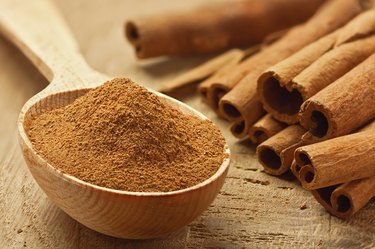
The body maintains a moderately alkaline environment, with a pH slightly above 7, according to September 2021 article in StatPearls. This alkaline pH is crucial for chemical reactions and proper function of the lungs, kidneys, intestines and skin.
The pH scale is used to tell us how acid-forming or alkaline-forming (or basic) a food is in the body, according to the Khan Academy. Anything with a pH value above 7 is alkaline-forming and anything with a pH value below 7 is acid-forming.
Video of the Day
Video of the Day
The foods you eat don't have much to do with your blood pH level — the body does a good job of maintaining it. But, eating alkaline spices or foods may affect something called your potential renal acid load (PRAL), which involves the kidneys and may affect your health, according to the University of California at San Diego (UCSD).
Eating too many acid-producing foods has also been linked to a higher risk of muscle breakdown and osteoporosis, per the UCSD.
Alkaline Spices
Certain spices are considered alkaline because they have a pH above 7. According to the UCSD, most spices are alkaline. The most alkaline spices are:
- Cinnamon
- Curry
- Ginger
- Chili pepper
- Black pepper
- All herbs, such as sage and mint
Many people wonder if cinnamon is acidic, but it is actually one of the most alkaline, with a pH ranging between 8 and 10.
On the other hand, salt has a neutral pH, meaning that it's neither acid-producing nor alkaline.
Nutmeg and mustard are not considered acidic, but they are less alkaline than the other spices, with pH levels just above 7, per the UCSD.
Tip
Prepping foods with alkaline spices can be an easy way to incorporate multiple alkaline food sources into one meal. For example, you can sprinkle ground ginger into a vegetable stir-fry or toss roasted sweet potatoes with cinnamon.
Other Alkaline Foods
Most fruits and vegetables are alkaline-producing, but some are more so than others, per the Judicial Branch of the California Government. Some of the most alkaline fruits and veggies include:
- Apple
- Cantaloupe
- Banana
- Avocado
- Apricot
- Asparagus
- Fermented Veggies
- Watercress
- Beets
- Legumes like peas and lentils
Most vegetables aren't acid-forming, but beans and legumes like black beans and chickpeas are. Fruits like blueberries, cranberries, plums and prunes are more acid-forming.
Nuts and seeds can serve as a satisfying and delicious snack as well as an alkaline food source, depending on the type you eat. Nuts like brazil nuts, cashews, peanuts and pistachios are more acid-producing, per the UCSD. The most alkaline-producing nuts and seeds are:
- Almonds
- Chestnuts
- Flaxseeds
- Sesame seeds
- Pine nuts
- Fresh coconut